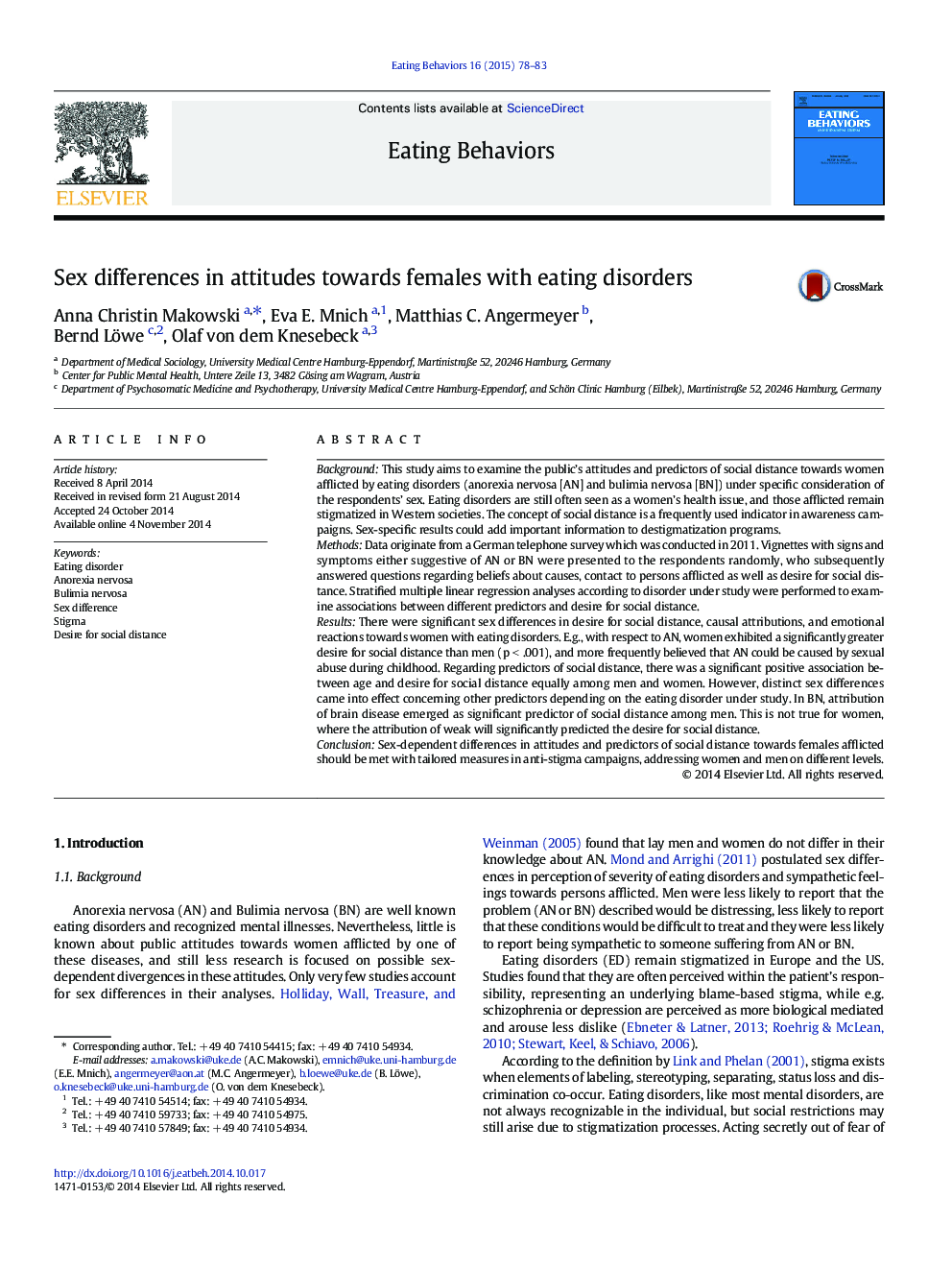| کد مقاله | کد نشریه | سال انتشار | مقاله انگلیسی | نسخه تمام متن |
|---|---|---|---|---|
| 906541 | 1472887 | 2015 | 6 صفحه PDF | دانلود رایگان |
کلید واژه ها
۱. مقدمه
۱.۱ سابقه
۲. روش ها
۱.۲ طراحی مطالعه و نمونه
جدول ۱. ویژگی های اجتماعی و جمعیت شناختی نمونه های مورد مطالعه در مقایسه با آمار رسمی.
۲.۲ معیارها
۱.۲.۲ نسبت های علی
۲.۲.۲ واکنش های احساسی
۳.۲.۲ فاصله اجتماعی
۴.۲.۲ تجزیه و تحلیل آماری
۳. نتایج
جدول ۲. اختلالات خوردن: نسبت های علی، واکنش های احساسی و فاصله اجتماعی بر اساس جنسیت
۱.۳ بی اشتهایی عصبی: ارتباطات بین میل به فاصله اجتماعی میان پاسخ دهندگان زن
جدول ۳. نتایج جنسیتی میل به فاصله اجتماعی نسبت به افراد مبتلا به بی اشتهایی عصبی ( (ANو یا پرخوری عصبی (BN) بر اساس سن، سطح تحصیلات، نسبت های علی و واکنش های احساسی.
۲.۳ بی اشتهایی عصبی: ارتباطات بین میل به فاصله اجتماعی میان پاسخ دهندگان مرد
۳.۳ پرخوری عصبی: ارتباطات بین میل به فاصله اجتماعی میان پاسخ دهندگان زن
۴.۳ پرخوری عصبی: ارتباطات بین میل به فاصله اجتماعی میان پاسخ دهندگان مرد
۴. بحث
۵. نتیجه گیری
۱.۵ محدودیت ها
ضمیمه الف) نسخه های اصلی تصاویر به زبان آلمانی نوشته شده است.
• Age emerges as significant predictor of desire for social distance for AN and BN.
• Women’s desire for social distance is predicted by attribution of weak will for BN.
• Men’s desire for social distance is predicted by attribution of brain disease for BN.
• Contact theory holds true for female respondents and in case of BN in this study.
BackgroundThis study aims to examine the public’s attitudes and predictors of social distance towards women afflicted by eating disorders (anorexia nervosa [AN] and bulimia nervosa [BN]) under specific consideration of the respondents’ sex. Eating disorders are still often seen as a women’s health issue, and those afflicted remain stigmatized in Western societies. The concept of social distance is a frequently used indicator in awareness campaigns. Sex-specific results could add important information to destigmatization programs.MethodsData originate from a German telephone survey which was conducted in 2011. Vignettes with signs and symptoms either suggestive of AN or BN were presented to the respondents randomly, who subsequently answered questions regarding beliefs about causes, contact to persons afflicted as well as desire for social distance. Stratified multiple linear regression analyses according to disorder under study were performed to examine associations between different predictors and desire for social distance.ResultsThere were significant sex differences in desire for social distance, causal attributions, and emotional reactions towards women with eating disorders. E.g., with respect to AN, women exhibited a significantly greater desire for social distance than men (p < .001), and more frequently believed that AN could be caused by sexual abuse during childhood. Regarding predictors of social distance, there was a significant positive association between age and desire for social distance equally among men and women. However, distinct sex differences came into effect concerning other predictors depending on the eating disorder under study. In BN, attribution of brain disease emerged as significant predictor of social distance among men. This is not true for women, where the attribution of weak will significantly predicted the desire for social distance.ConclusionSex-dependent differences in attitudes and predictors of social distance towards females afflicted should be met with tailored measures in anti-stigma campaigns, addressing women and men on different levels.
Journal: Eating Behaviors - Volume 16, January 2015, Pages 78–83
